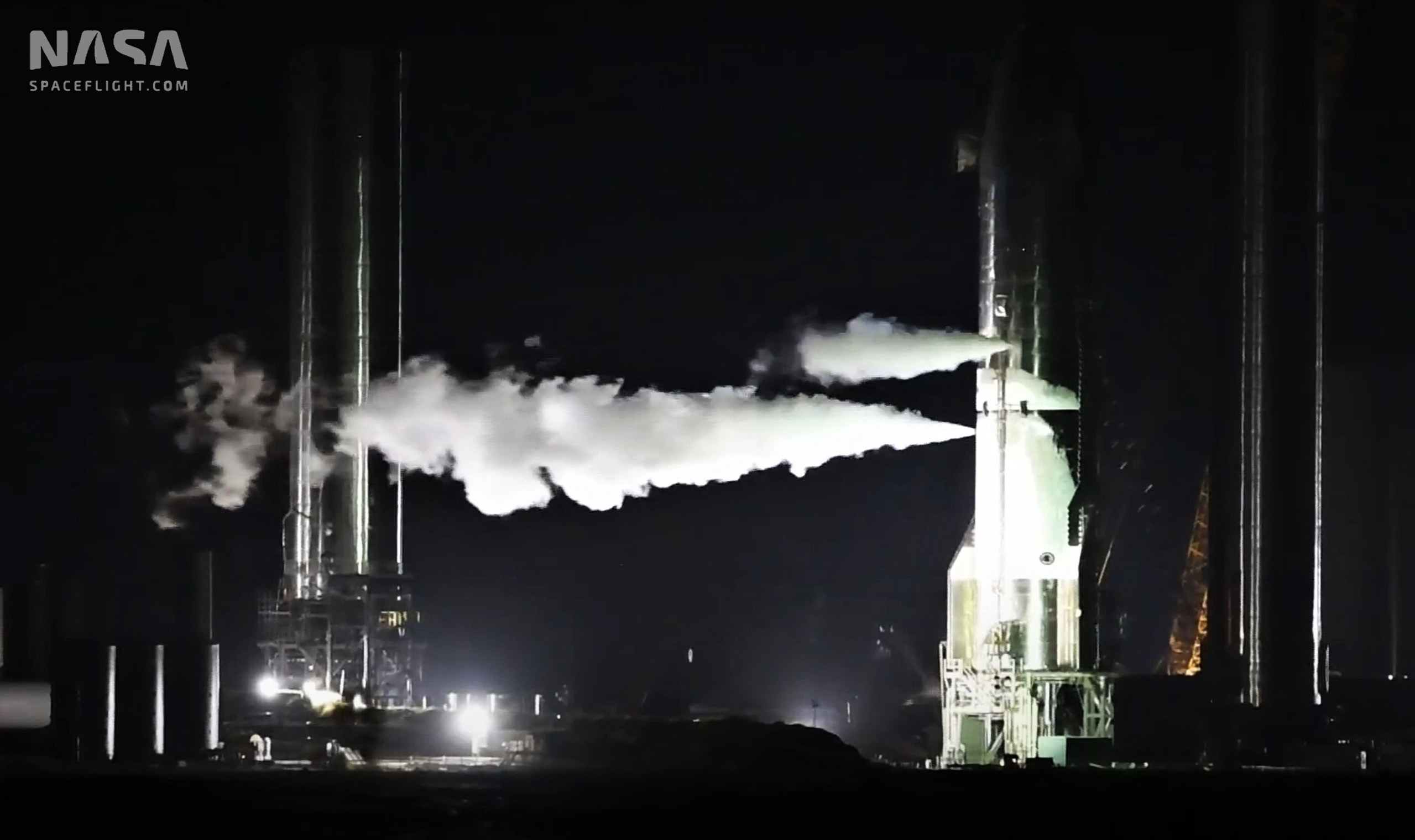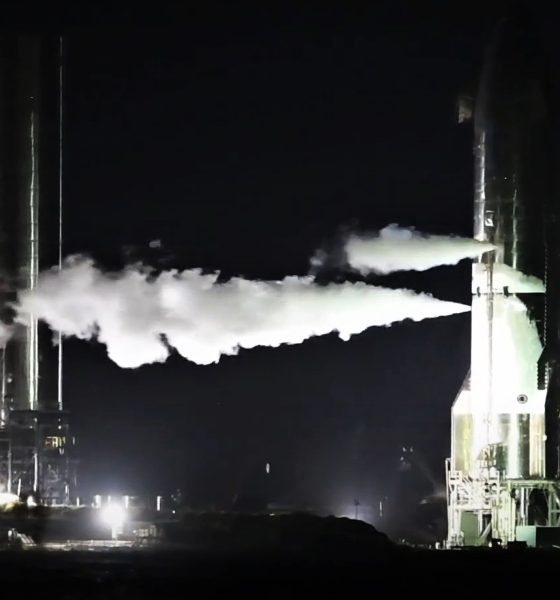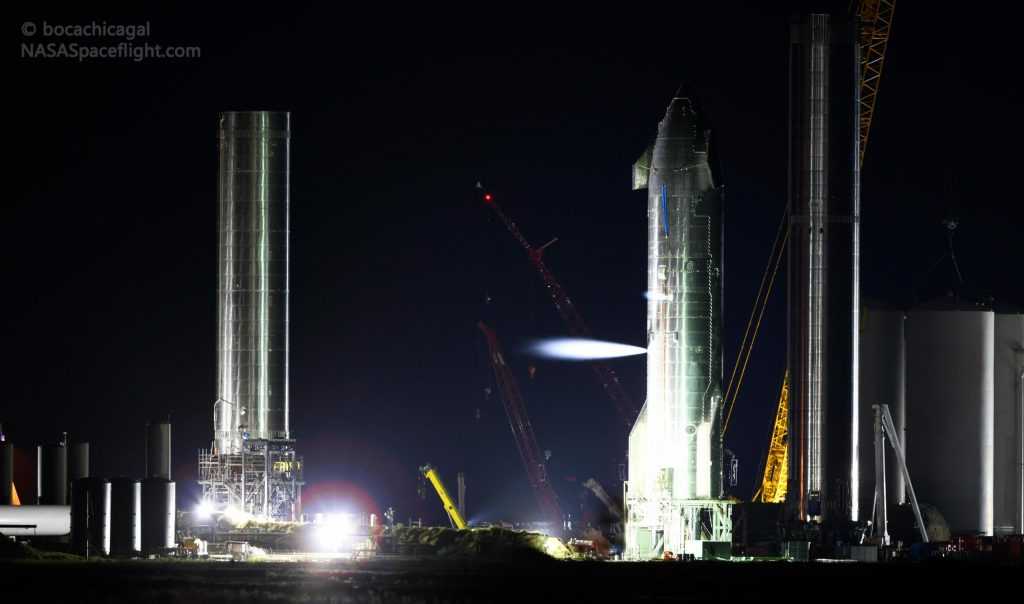

News
SpaceX’s orbital Starship prototype gets frosty during first successful ‘cryoproof’
For the first time, SpaceX has put the first orbital-class Starship – a prototype known as Ship 20 (S20) – through a routine cryogenic proof test, filling the rocket with several hundred tons of liquid nitrogen to simulate its explosive propellant.
While it’s impossible to jump to conclusions before members of the public can return to the pad to take photos or CEO Elon Musk takes to Twitter to discuss the results, Ship 20’s first ‘cryoproof’ appears to have been largely successful [Edit: Musk has confirmed that the test went well]. Relative to the almost three-dozen cryoproofs SpaceX has completed with more than a dozen other Starship, booster, and test tank prototypes over the last two years, though, Ship 20’s first major test still has some oddities.
Historically, every cryoproof of a full Starship prototype has been visually unique and virtually impossible to predict. Without any direct insight from SpaceX or Elon on the objectives, plan, or timeline of tests, the process of watching tests (via unofficial webcams, of course) and attempting to interpret why certain things look the way they do or what’s going on at any given moment is a bit trying to interpret eroded hieroglyphics.
At the most basic level, cryogenic tanking tests – whether with Starship, Super Heavy, or test tanks and liquid oxygen (LOx)/methane (LCH4) propellant or neutral liquid nitrogen (LN2) – are fairly simple. The vehicle is attached to pad systems, powered on, and partially or fully loaded with cryogenic fluids. Once the desired test objectives are achieved or attempted, the vehicle is then detanked (drained of propellant or LN2).
Thanks to the fact that they’re incredibly cold (-160 to -200C; -260 to -330F), the LOx/LCH4 or LN2 Starships are filled with quickly chill the thin steel tanks containing them. With no insulation to speak of, that supercooled steel then freezes water vapor out of the humid South Texas air, creating a layer of frost/ice that generally follows the level of the cryogenic liquids in Starship’s tanks. Throughout that process, those cryogenic liquids inevitably come into contact with ambient-temperature Starship tanks and plumbing (white-hot in comparison) and warm up, boiling off into gas as a result.
A gaseous chemical is far less dense than its liquid form, meaning that the pressure inside Starship’s fixed tanks can rapidly become unmanageable after even a small amount of boiloff. To maintain the correct tank pressures, Starship – like all other rockets – occasionally vents off the gas that forms. And thus, the two main methods of interpreting the hieroglyphics that are cryoproof tests: frost levels and venting.
Compared to earlier prototypes, Starship S20’s first cryoproof has been… unusual. Most notably, SpaceX began loading the rocket with liquid nitrogen around 8pm CDT. Its LOx (bottom) and CH4 (top) tanks were then slowly filled to around 30-50% of their full volume over the next hour. However, rather than detanking, SpaceX then partially drained the methane tank but filled the LOx tank further before leaving the LOx tank more or less fully filled for more than two hours, occasionally topping it off with fresh liquid nitrogen.
Then, almost four hours after LN2 loading began, Starship performed several massive vents. Ordinarily, given the hours of testing prior, those vents would have assuredly been detank vents – effectively depressurizing Starship’s tanks as they’re drained of fluid. However, those vents instead coincided with the rapid loading of one or several hundred more tons of LN2, seemingly topping off Starship S20 in the process. Around that point, it’s possible that SpaceX began the pressure testing portion of Ship 20’s cryoproof, (mostly) closing the rocket’s vents and allowing the pressure to gradually increase to flight levels (and maybe even higher).
Many, many months ago, when SpaceX was deep into cryoproofing the first full-size Starship prototypes, Musk revealed an operating pressure goal of 6 bar (~90 psi). Ships were eventually successfully tested above 8 bar (~115 psi), giving Starship a healthy ~30% safety margin. As the first orbital-class Starship prototype, Ship 20 likely needs to hit those tank pressures more so than any ship before it to have a shot at surviving its orbital launch debut and orbital-velocity reentry attempt.

Beyond the basics of cryoproofing, Starship S20 also marked a crucial step forward on September 29th/30th, becoming the first ship to complete a cryoproof test with a full heat shield installed. While it’s impossible to judge exactly how well S20’s ~15,000-tile heat shield performed, views from public webcams showed no obvious signs of tiles shattering and falling off as Starship repeatedly cooled and warmed – contracting and expanding as a result. Additionally, still in contact with the air, the steel tank skin under a majority of Ship 20’s tiles would have likely covered itself in a layer of frost and ice, but the heat shield appeared to handle that invisible change without issue.
It’s possible that dozens or hundreds of tiles bumped together and chipped or cracked in a manner too subtle to be visible on LabPadre or NASASpaceflight webcasts, but that can only be confirmed or denied when the road reopens and local photographers can capture higher-resolution views of Starship. For now, it appears that Ship 20’s first cryoproof was highly successful, hopefully opening the door for Raptor installation and static fire testing in the near future. Stay tuned for more!
Update: As is almost tradition by now, SpaceX CEO Elon Musk didn’t take long to tweet about the results of Starship S20’s first cryoproof, confirming that the “proof was good!”

Investor's Corner
Tesla gets price target bump, citing growing lead in self-driving

Tesla (NASDAQ: TSLA) stock received a price target update from Pierre Ferragu of Wall Street firm New Street Research, citing the company’s growing lead in self-driving and autonomy.
On Tuesday, Ferragu bumped his price target from $520 to $600, stating that the consensus from the Consumer Electronics Show in Las Vegas was that Tesla’s lead in autonomy has been sustained, is growing, and sits at a multiple-year lead over its competitors.
CES 2026 validates Tesla’s FSD strategy, but there’s a big lag for rivals: analyst
“The signal from Vegas is loud and clear,” the analyst writes. “The industry isn’t catching up to Tesla; it is actively validating Tesla’s strategy…just with a 12-year lag.”
The note shows that the company’s prowess in vehicle autonomy is being solidified by lagging competitors that claim to have the best method. The only problem is that Tesla’s Vision-based approach, which it adopted back in 2022 with the Model 3 and Model Y initially, has been proven to be more effective than competitors’ approach, which utilizes other technology, such as LiDAR and sensors.
Currently, Tesla shares are sitting at around $433, as the company’s stock price closed at $432.96 on Tuesday afternoon.
Ferragu’s consensus on Tesla shares echoes that of other Wall Street analysts who are bullish on the company’s stock and position within the AI, autonomy, and robotics sector.
Dan Ives of Wedbush wrote in a note in mid-December that he anticipates Tesla having a massive 2026, and could reach a $3 trillion valuation this year, especially with the “AI chapter” taking hold of the narrative at the company.
Ives also said that the big step in the right direction for Tesla will be initiating production of the Cybercab, as well as expanding on the Robotaxi program through the next 12 months:
“…as full-scale volume production begins with the autonomous and robotics roadmap…The company has started to test the all-important Cybercab in Austin over the past few weeks, which is an incremental step towards launching in 2026 with important volume production of Cybercabs starting in April/May, which remains the golden goose in unlocking TSLA’s AI valuation.”
Tesla analyst breaks down delivery report: ‘A step in the right direction’
Tesla has transitioned from an automaker to a full-fledged AI company, and its Robotaxi and Cybercab programs, fueled by the Full Self-Driving suite, are leading the charge moving forward. In 2026, there are major goals the company has outlined. The first is removing Safety Drivers from vehicles in Austin, Texas, one of the areas where it operates a ride-hailing service within the U.S.
Ultimately, Tesla will aim to launch a Level 5 autonomy suite to the public in the coming years.
Elon Musk
Elon Musk’s Biggest Revelations on AI, Robots, and the Future of Work from the Moonshots Podcast

Elon Musk’s appearance on the Moonshots with Peter Diamandis podcast was packed with bold predictions, candid admissions, and surprising tech insights. The nearly three-hour conversation covered everything from artificial intelligence to humanoid robots, geopolitics, and the future of work. Here are the top 10 most intriguing takeaways:
-
Aggressive AGI Timeline Predictions
Musk offered a detailed view on when artificial general intelligence (AGI) could emerge, suggesting it may arrive sooner than many expect, emphasizing both transformative potential and risks.
-
U.S. vs. China in the AI Race
He discussed the strategic competition between the United States and China over AI development, noting that geopolitical dynamics will shape how and who leads in the next decades.
-
Future of Job Markets
Musk touched on how AI and automation could reshape employment, predicting massive boosts in productivity alongside potential disruptions in traditional work structures.
-
Clean Energy Transition
A recurring theme was the role of clean energy in future economies, with Musk reiterating the importance of scaling sustainable power generation and storage.
-
Humanoid Robots Are Coming
On the podcast, Musk elaborated on Tesla’s work on humanoid robots, hinting at timelines and applications that go beyond factories to general-purpose assistance.
-
Tesla Roadster “Last Human-Driven Car”
Outside the core discussion topics, Musk teased features of the upcoming Tesla Roadster — calling it “the best of the last of the human-driven cars” and suggesting safety won’t be its main selling point.
-
The Role of AI in Clean Energy and Robotics
Linking AI to both energy optimization and robotics, Musk explained how smarter systems could accelerate decarbonization and task automation across industries.
-
U.S. Innovation Leadership
Musk argued that maintaining American leadership in key tech sectors like AI, space, and robotics should be a national priority, with thoughtful policy and investment.
-
Job Creation vs. Job Elimination
While acknowledging automation’s disruptive effects, he also outlined scenarios where new industries and opportunities could emerge, particularly in AI, space, and advanced manufacturing.
-
Long-Term Vision for Humanity
Throughout the conversation, Musk revisited his long-term philosophical views — including a belief in humanity’s responsibility to become a multi-planetary and technologically empowered species.
Whether you agree with Musk’s optimism or not, the podcast offers a window into the thinking of one of the most influential figures in tech today, in and why his visions continue to spark debate and inspiration.
Elon Musk
Elon Musk just said some crazy stuff about the Tesla Roadster

Elon Musk appeared on the Moonshots podcast with Peter Diamandis today to discuss AGI, U.S. vs. China, Tesla, and some other interesting topics, but there was some discussion about the upcoming unveiling of the Roadster, the company’s electric supercar that will arrive several years after it was initially slated for release.
Musk made some pretty amazing claims about the Roadster; we already know it is supposed to be lightning-fast and could even hover, if Tesla gets everything to happen the way it wants to. However, the car has some pretty crazy capabilities, some of which have not even been revealed.
On the podcast, Musk said:
“This is not a…safety is not the main goal. If you buy a Ferrari, safety is not the number one goal. I say, if safety is your number one goal, do not buy the Roadster…We’ll aspire not to kill anyone in this car. It’ll be the best of the last of the human-driven cars. The best of the last.”
🚨 Elon on the Roadster unveiling, scheduled for April 1:
— TESLARATI (@Teslarati) January 6, 2026
Musk makes a good point: people who buy expensive sports cars with ridiculous top speeds and acceleration rates do not buy them to be safe. They hope they are safe in case of an emergency or crash, but safety is not at the forefront of their thoughts, because nobody buys a car thinking they’ll crash it.
The Roadster is truly going to push the limits and capabilities of passenger vehicles; there’s no doubt about that. Tesla plans to show off the new version car for the first time on April 1, and Musk has only hinted at what is possible with it.
Musk said back in November:
“Whether it’s good or bad, it will be unforgettable. My friend Peter Thiel once reflected that the future was supposed to have flying cars, but we don’t have flying cars. I think if Peter wants a flying car, he should be able to buy one…I think it has a shot at being the most memorable product unveiling ever. [It will be unveiled] hopefully before the end of the year. You know, we need to make sure that it works. This is some crazy technology in this car. Let’s just put it this way: if you took all the James Bond cars and combined them, it’s crazier than that.”
Production is set to begin between 12 and 18 months after the unveiling, which would put the car out sometime in 2027. Hopefully, Tesla is able to stay on track with the scheduling of the Roadster; many people have been waiting a long time for it.








